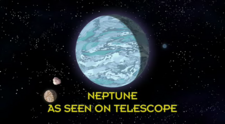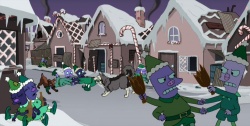Neptune
| Neptune | |
|---|---|
| Location | Sol System |
| Star | Sol |
| Inhabited by | Neptunians; Robot Santa; Neptunian Slugs |
| Member of | DOOP |
| First appearance | "A Tale of Two Santas" (3ACV03) |
Neptune is the eight planet in the Sol system. Neptune supports life and is the homeworld of Neptunians. It is unknown how is this possible, as it is a gas giant, and anything living on it would fall straight through until crushed by pressure. Neptune has many moons, such as Triton.
Inhabitants
- Main article: Neptunians
Neptune's main inhabitants are Neptunians, many of which have moved to Earth, where they have formed minority areas in cities like New New York, such as Little Neptune. Neptune is largely an ally with Earth and a member of the Democratic Order of Planets.
History
On Futurama, the planet has only been visited twice, and only near the North Pole of Neptune, where Robot Santa has his Death Fortress. The North Pole hosts a single village, Jolly Junction, which is in inhabited by the servants of Robot Santa, whom are basically shrimpy Neptunians, because he doesn't feed them. Their main function is to build the toys, but since Robot Santa judges everyone as naughty, his servants basically do nothing. During the two visits by the Planet Express crew, the toy factory has been reopened, if only for a brief period.
Neptune also hosts other exotic animals, such as the Neptunian Slug, a key ingredient in Neptunian food according to Elzar, that can be obtained on Earth, and the Yetis, giant white creatures who may attempt to eat those who interlope on their land.
Locations of Interest
- North Pole of Neptune
- Death Fortress: Robot Santa Claus lives here
- Santa's workshop (closed): The place where the Toys for Christmas were made
- Crack House (proposed): Located in Toy Factory building
- Jolly Junction: The little Neptunian workers live here
- Triton, Neptune's largest moon.
Additional Info
Trivia
- The Arctic-esqe planet Neptune in Futurama may be a different planet from the gas giant Neptune.
- Between 2000—3000, the original Neptune might have been replaced by the current Neptune.
- It is also possible that Neptune never was a gas giant at all (despite what Earth's scientists believed), or some unmentioned effect allows for areas of solid matter with life.
Appearances
- "My Three Suns" (1ACV07) (mentioned in speech only)
- "A Big Piece of Garbage" (1ACV08) (mentioned in speech only)
- "Bender Gets Made" (2ACV13) (mentioned in speech only)
- "A Tale of Two Santas" (3ACV03)
- "The Birdbot of Ice-Catraz" (3ACV05)
- Bender's Big Score

